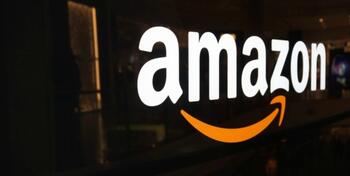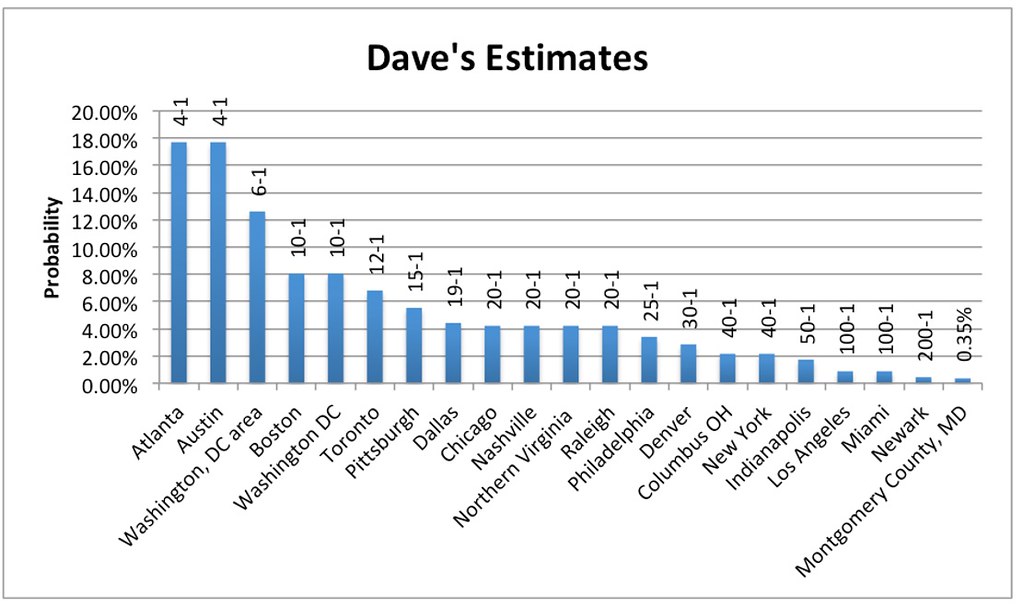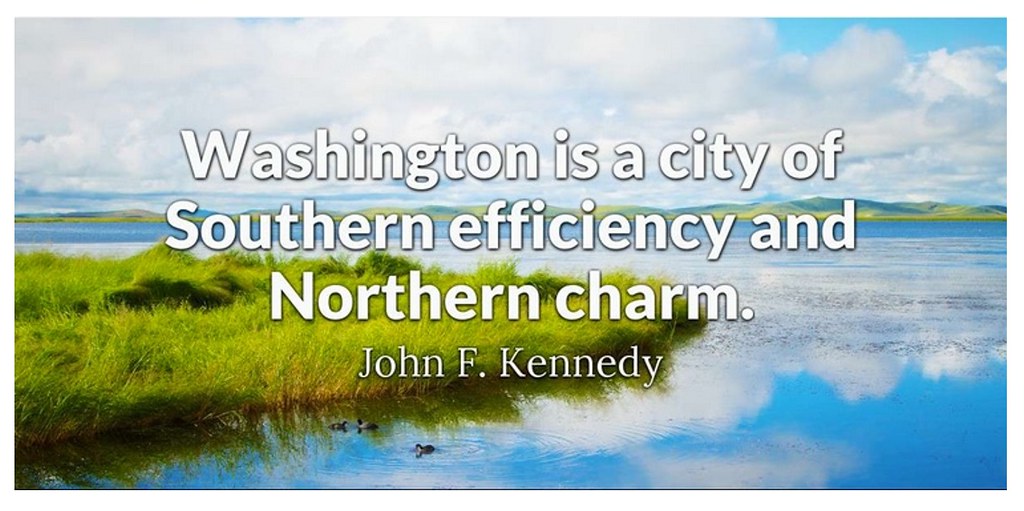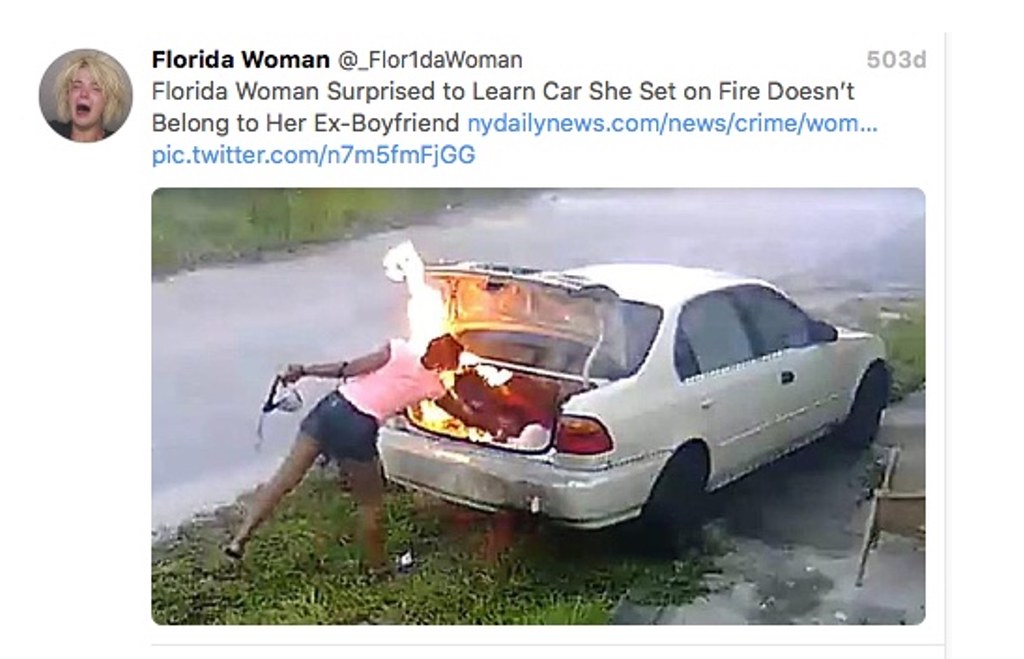
Amazon is choosing a city for their second headquarters. The retail behemoth released its “short list” of the 20 cities on January 18.
With tongue planted firmly in cheek, well-known tweeter Iowahawk (@iowahawkblog aka Austin’s David Burge) has enumerated the pros and cons of each location. He swagged the odds for each city.
Atlanta and Austin top his list with 4-1 odds on each. (Austin? Hometown bias?) Way down at the bottom are Miami (100-1), Newark, NJ (200-1), and Montgomery County, MD (250-1). All the data is available via here. A much longer analysis is available at here.
Three of the 20 finalists are located right next to each other. Do you think maybe Jeff Bezos wants another reason to visit the DC area? Remember, he already owns the Washington Post. The Washington, DC area is the sum of the probabilities for Washington, D.C., Northern Virginia, and Montgomery County, MD. (From this point forward, Mr. Burge will be “Dave” and Mr. Bezos will be “Jeff.”)
Many, including me, believe that Jeff has already made his decision. The true objective of having 20 finalist cities is to encourage competition among them for the HQ. This competition includes various tax breaks, tax incentives, and outright payments from the city’s coffers. One important point: Jeff owns houses in both New York and Washington.

Google Maps. Regional annotation by author
Dave’s analysis focuses on quality of life for employees. I’ll add comments on three other considerations:
1. Jeff’s personal life goals
2. Strategies for the long-run growth of Amazon
3. Jeff may believe that transplanting a large number of Amazon employees to a state could flip the state from red to blue (Republican to Democrat).
Here’s a graph of the results. Probabilities are on the vertical axis and the odds are above each bar.

The Pros and Cons
The real fun is Dave’s snarky comments on the pros and cons of each city. The table presentation is what he said. My perceptive rejoinders follow.
1. Atlanta

In 1996 Atlanta hosted the summer Olympics. During the opening ceremony, a bunch of doves were released. The day before one wag noted that this was a bad idea. “You just know there will be a dozen or so rednecks with shotguns outside the stadium.” Georgia is pretty much prime second amendment territory. I suspect the sheer number of rednecks will be a negative for Jeff. Georgia is a solid red state. It’s unlikely that putting Amazon in Atlanta will flip the state to blue. Atlanta is ranked too high.
2. Austin

Austin is also ranked too high. This is the city that banned Uber and Lyft. The capital of the Texas is also a small oasis of progressiveness in an expansive hotbed of conservatism. Offsetting this, Jeff is a Texas native. Surprisingly, Dave failed to note the presence of the University of Texas, a college made great by virtue of spending the money of polluters on progressive goals. Among their illustrious faculty is Bob Metcalfe, the inventor of Ethernet. If anything, the presence of U of T should give Austin a boost in the rankings. And it’s unlikely Texas will flip from red to blue unless Jeff moves several hundred thousand workers to his new HQ. Austin should not be in the top five.
3. Boston

Boston is ranked way too high. The city combines hellacious traffic jams with killer winters. Driving is impossible. Boston streets were laid out following the original cow paths to the Boston Common. And the drivers are, well, nuts. If you visit that fair city, take taxis. You want a road warrior behind the wheel. And as for the weather, Boston is located directly along the freeze line. That means during the winter it warms up during the day and melts the snow. At night, the temperature drops and that water freezes. The street layout and drivers are bad enough. Summers can be bummers, too. One summer when I lived there it rained every single weekend. It started raining on Friday and stopped on Monday.
There are many fine universities in Boston. MIT and Harvard are located in Cambridge, across the Charles River.
Finally, Massachusetts is a solid blue state. There’s no point in making an already blue state even deeper blue.
4. Washington, D.C.

Jeff’s personal preferences may well come into play here. For purely business reasons, Washington DC is ranked way too high. Traffic as bad as anywhere in the country combined with a mass transit system that rivals New York City for unreliability should put our nation’s capital further down the list. (The NYC subway floods. The DC metro catches fire.) Also there are terrible public schools in the district and a local government that shuts down when a single snowflake falls.
Finally, I need to remind Dave of this quote from John F. Kennedy.

5. Toronto

Toronto seems ranked just about right.
One overlooked positive is for those who vowed to emigrate to Canada if Mr. Trump was elected president. If Toronto is selected they can fulfill their promise and work for a large U.S. company. It’s a win-win! But Toronto, like every other city and province in Canada, has no votes in U.S. elections. That counts against them using the “flip the state from red to blue” criterion.
6. Pittsburgh

Pittsburgh is ranked a bit too low. The few times I’ve visited I’ve found it to be a pretty nice town. And Carnegie-Mellon is a first class university.
In many respects, Pittsburgh is what Portland (OR) was 30 years ago. Real estate prices are low. The downtown is gradually being taken over by hipsters. And Pennsylvania is always in play politically. The drawback is the state’s large population, 12.8 million. Adding 20,000 Amazon workers won’t make much difference.
7. Dallas

Dallas is ranked about right. Pluses are low housing costs, Texas conservatism, friendly regulation, and a pro-business climate. One negative is, um, the climate. Winters can be very cold, snowy, and windy.
Jeff ain’t gonna turn Texas blue in his lifetime.
8. Chicago

Illinois? Are you kidding me? Chicago should not be in the top 15. High taxes, a state government that regularly sees governors sentenced to prison, a shrinking population, and way too much influence from Chicago in Springfield. Now let me tell you about the murder rate.
Despite having a Republican governor, both Chicago and Illinois are dominated by a Democratic political machine. Like Massachusetts, Jeff shouldn’t try to make a blue state even deeper blue.
9. Nashville

Nashville is the sleeper of this bunch. It should be in the top three. Start with a bonus: the city is a mere 212 miles from Memphis, making weekend visits to Graceland easy. Also, Memphis is also the original hub for FedEx. Company history says that city was chosen because the airport rarely closes due to weather. If Nashville’s airport is closed, fly into Memphis and drive.
I once worked with a guy who travelled a lot. He lived in Los Angeles. A few years later he moved to Nashville. A big plus is a first-rate international airport. Those musicians need to be able to get to and from the Grand Ole Opry.
Nashville is easy to get around and has high quality hotels and restaurants. Plus there’s plenty of convention space. And Tennessee has a low cost of living, business-friendly government, and some nice schools. Vanderbilt, for example, is located in Nashville. I would take Dave’s 20-1 odds and bet on Nashville.
10. Northern Virginia

One criticism of Dave’s odds is that Washington, DC, Northern Virginia, and Montgomery County, MD are basically the same place. Therefore they should have similar odds. About the only thing Maryland and Virginia have in common is proximity to Washington. But it still disturbs me that three of the 20 sites are Washington, DC and its suburbs. Jeff Bezos will not be happy with the taxes and regulations in deep blue Maryland, although it has a Republican Governor. Does Amazon really need a supply of cyanide and/or strangling wire?
On the other hand, Virginia is a swing state that has been trending slightly blue. This has been largely caused by federal government workers living across the Potomac River in Alexandria and other suburbs. Another 20,000 Amazon workers might hasten the trend to blue.
11. Raleigh

Raleigh is just out of the top ten. That seems about right. The Raleigh-Durham area is home to Duke University and the University of North Carolina. College basketball and car racing are huge here. Raleigh is 156 miles from Charlotte, home of the Charlotte Motor Speedway and the NASCAR Hall of Fame. Another plus is very affordable real estate and access to North Carolina wineries, all 131 of them.
But it’s still located in North Carolina. The thin veneer of civilization is especially tenuous once you get out in the country. The state has remained solidly red in presidential elections since 1980 with one exception. In 2008 the voters chose former President Obama.
12. Philadelphia

The real mystery here is why Philadelphia is even on this list. The 12th place ranking is way too high. Philadelphia government is about as corrupt as it gets; Pennsylvania politicians are second only to Illinois in ending up in jail. In 2016 former state Attorney General Kathleen Kane was sentenced to 10 to 23 months in prison for operating a political payback scheme.
Unless Jeff plans to go the bribery and corruption route for his new HQ, he should probably avoid this place. Although it is affordable compared to DC, Boston or New York.
There is, once again, little hope of turning the state blue and no need to turn Philadelphia any more blue. See the earlier discussion of Pittsburgh for details. Remember, fully 59 Philadelphia precincts did not cast one single vote for Mitt Romney in the 2012 presidential race.
13. Denver

This is the correct ranking for Denver. I doubt very much that access to beer and weed are in Amazon’s plus column. Denver is the second-highest state capitol in the U.S. (Win bar bets with this one: highest is Santa Fe, NM.) Unless you correct for weed consumption, in which case Denver is a whole lot higher. But housing is becoming less affordable but there is fine skiing. Also the Eisenhower Tunnel on I-70 is worth a trip unless you’re even slightly claustrophobic.
When it comes to voting, Colorado has been trending blue since 2008. With only nine electoral votes, there would be little point trying to turn the state completely blue.
14. Columbus, OH

I have no idea whether Columbus is ranked correctly or not. If you want to understand Dave’s cryptic comments, read the (much) longer version at GonzoEcon.com.
Columbus has affordable housing, as well as combining the virtues of being the state capital and the home to a pretty good college football team. But there’s no way 20,000 Amazon employees are going to change the voting statewide or in Columbus.
15. New York

Even in 15th place, New York is rated too high. New York City is expensive, crowded, and has a public transportation system that is glaringly flawed. The failure of public transportation has encouraged the rise of Uber and Lyft. That, of course, has increased street congestion. Both the state and the city have business-hostile governments. Mayor Bill de Blasio murdered a groundhog. The New York Post was all over the story.
Mayor Bill de Blasio has groundhog blood on his hands!
However, Mayor de Blasio did not kill Eric Garner (the illegal cigarette vendor presumably referenced by Dave).
16. Indianapolis

Indianapolis is 51 miles northeast of Bloomington, home of Indiana University. If you don’t get the reference to high school basketball, go watch “Hoosiers." And, of course, Memorial Day weekend the city is mobbed with people heading to the Indianapolis 500. Indianapolis is centrally located, livable, and has a reasonable cost of living. It should be ranked higher, at least with Columbus.
17. Los Angeles

I’m a little surprised that Dave ranked L.A. this low. But as a fairly frequent visitor to the City of Angels, he he knows about (but didn’t mention) the exorbitant cost of housing, high state taxes, massive state and local regulations, impossible traffic, and a city government that taxes everything it can think of. But he’s ranked it number 17, probably about right.
18. Miami

Not to be confused with Miami, Ohio. Miami, Florida, is a wannabe Los Angeles but with bugs, bugs, bugs. Really big bugs.
And Florida’s inhabitants are about the weirdest anywhere in the U.S. Go check @_FloridaMan and @_Flor1daWoman. Both accounts have not been active recently. But here’s one example:

If not for Newark, Miami would rank dead last.
19. Newark

Fun fact: there is a Newark, California.
There is no way Newark can be on Jeff’s real short list. About the only positive thing is an international airport. But that’s it. The city’s ranking is spot on.
20. Montgomery County MD

I’m not sure why Dave ranks this lower than Newark. Just another one of the three Washington, DC locations. And it is also heavily populated by DC bureaucrats. Montgomery County should be ranked much higher, at least closer to Northern Virginia and Washington, DC.
Odds and Probabilities
Here’s Dave’s complete list ranked by probability.

Readers who also have too much time on their hands will notice that the probabilities add up to 112.96 percent. The sum should be 100 percent since (presumably) only one city will actually be selected. If you’re interested, click the link in the following section.
DIY Odds and Data
If you’d like to do your own odds, the entire Excel workbook I put together, including instructions and sources, is available here.
Tony Lima is Professor Emeritus of Economics at California State University, East Bay. He is a card-carrying, published wine economist.
Photo: Via Flex Jobs.













Warning
Warning. Don't read in bed while drinking morning coffee. Snorted all over.